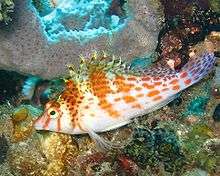Dwarf hawkfish
| Dwarf hawkfish | |
|---|---|
 | |
Not evaluated (IUCN 3.1) | |
| Scientific classification | |
| Kingdom: | Animalia |
| Phylum: | Chordata |
| Class: | Actinopterygii |
| Order: | Perciformes |
| Family: | Cirrhitidae |
| Genus: | Cirrhitichthys |
| Species: | C. falco |
| Binomial name | |
| Cirrhitichthys falco J. E. Randall, 1963 | |
| Synonyms | |
| |
The dwarf hawkfish, Cirrhitichthys falco, is a small species of hawkfish found on tropical reefs in the Indo-Pacific region from the Maldives to the Caroline Islands and Samoa. It can sometimes be found in the aquarium trade.[1]
Description
The dwarf hawkfish can reach 7 cm (2.8 in) in total length. The dorsal fin has ten spines with numerous tassels on the tips of the spines. The anal fin has three spines and six soft rays. The pectoral fins are thick and elongated and spread out when the fish is resting on the substrate. This fish is pinkish-red and white in color with vertical banding or mottling.[1]
Distribution and habitat
The dwarf hawkfish is native to the tropical Indo-Pacific. Its range extends from the eastern coast of Africa and the Maldives to Samoa, the Ryukyu Islands, northern Australia, the Great Barrier Reef and New Caledonia. It is a common member of the reef community on outer reef slopes and flats and is found at depths down to about 45 m (148 ft).[1]
Behavior
The dwarf hawkfish typically rests at the bottom of massive corals. It usually occurs singly but may be in pairs and feeds on fish larvae, small crustaceans and other invertebrates on the seabed.[1]
Like many fish, this species can change sex. A dominant male keeps a harem of several females. If a harem becomes too large, one of the females may become a male and take on part of the harem as a dominant male. What makes this species unusual is that the new male may revert to the female sex if challenged by a more powerful male. A male can become a female and successfully breed, laying fertile eggs.[2]
References
- 1 2 3 4 "Cirrhitichthys falco Randall, 1963: Dwarf halkfish". FishBase. Retrieved 2013-12-26.
- ↑ Whyte, C. Transgender fish perform reverse sex flip. New Scientist January 6, 2012.
External links
| Wikimedia Commons has media related to Cirrhitichthys falco. |
| Wikispecies has information related to Cirrhitichthys falco |